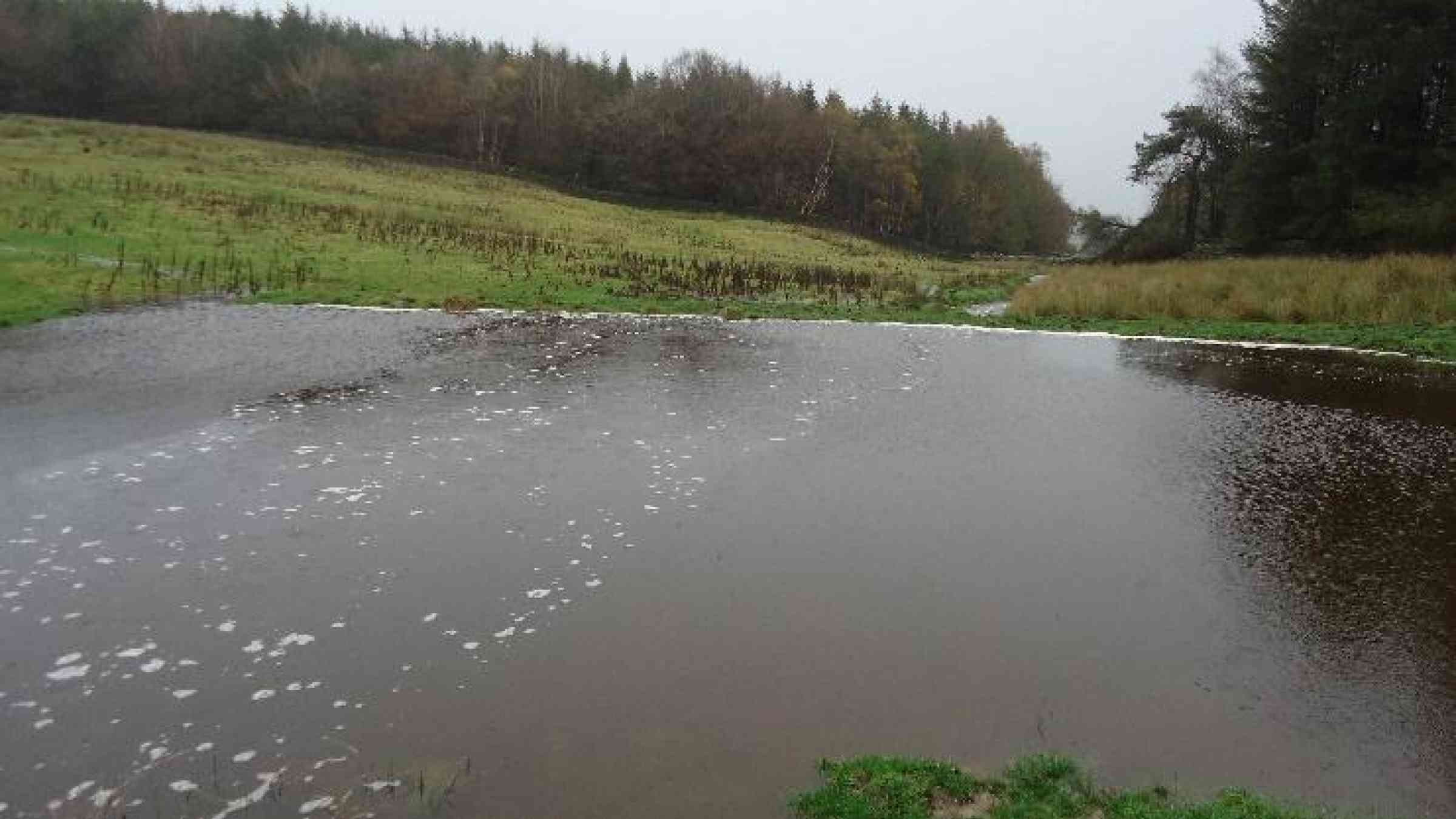Please help us improve PreventionWeb by taking this brief survey. Your input will allow us to better serve the needs of the DRR community.
United Kingdom: Natural flood management protects local communities

a leaky pond full
Many smaller communities at risk of flooding do not benefit from the larger and more traditional (‘hard’) flood risk management measures. This is frequently because the total number of properties at risk locally are usually low and fall short of the UK Environment Agency’s eligibility criteria. Nevertheless, the increased frequency and magnitude of flood events over recent years has damaged and destroyed many homes and businesses in these locations. Local communities are therefore coming together to fight for action and actively want to be part of the wider management process.
Given that hydrological catchments are linked (land and water, upstream to downstream), they often suffer from multiple pressures besides flooding. For instance, water quality (pollution) and rapid erosion and deposition of sediment in unwanted locations, are also closely aligned with high velocities and discharges.
Newcastle University’s ‘Proactive Catchment Management’ research group (Water Resources, School of Civil Engineering and Geosciences) has been involved in a number of initiatives relating to ‘Natural Flood Management’ (NFM) across the country. The concept of NFM involves working with natural processes above an impact zone to store, slow and filter water within the natural landscape. This process allows flood peaks to be reduced and attenuated, pollution to settle out and sediment to be captured before they cause adverse impacts downstream. This means that the features installed can offer multiple benefits in a more low-cost and natural way. A suite of carefully designed and managed (therefore ‘engineered’) NFM features have been trialled in a number of locations by a team of researchers led by Dr Paul Quinn, a Senior Lecturer in Catchment Hydrology. A key aspect the team’s work includes engaging with the local community and working with land owners in order to install site-specific and more sustainable solutions. They are also currently looking at the feasibility and impact of scaling up the use of NFM features across larger areas.
Case study: Slaty Sike runoff management measures (Haltwhistle in Northumberland, UK)
Led by Tyne Rivers Trust, and part of a larger Defra and Environment Agency funded project focusing on water quality across the whole burn, a set of Slaty Sike NFM features were developed in response to ongoing problems highlighted by the local community downstream in the Haltwhistle Burn. Although the Haltwhistle community is at risk of flooding, poor water quality and the build-up of sediment and stones exacerbates this risk.
Following the collection of local knowledge and engagement with the local River Watch community group, the 1km2 Slaty Sike sub-catchment was chosen to be used as a demonstration site to pilot two key NFM features which consists of:
- Four ‘leaky ponds’ which have been designed to slow down the flow of the water and trap silt at times of high flow. Earth bunds on the downstream end of the ponds hold back the water and a small outlet pipe allows it to be released more slowly once the peak of the storm has passed. These ponds therefore break the energy of the water so that it is less destructive downstream and act as fine sediment traps;
- A 60m long ‘leaky dam’ consisting of a ladder of criss-cross logs pinned into the banks of the Slaty Sike. The design has been inspired by the children’s game Kerplunk, allowing it to trap stones and debris which would normally be washed away downstream to the road culverts. This analogy has also helped to educate the public and understand the concepts of NFM.
Both features described have a primary purpose of slowing the flow and trapping sediment. In doing so, they subsequently aim to tackle flooding issues downstream and are thus a great example of reducing multiple problems which are common in many rural landscapes. They are also ‘softer’ on the surrounding landscape which the local community have praised.
Eleanor Starkey, a PhD student at Newcastle University who is responsible for monitoring the impact of the system, along with the local River Watch group, explains: “The UK has seen an increase in the number of extreme weather events over the past decade and at Newcastle University, we are working on a number of Natural Flood Management schemes to help our environment cope with this changing climate.”
“Slaty Sike is a good example of a catchment that copes well under normal weather conditions but when the area is hit by bigger storms, we see a rapid flow of water down the catchment, washing debris and stones into the Burn. The involvement of the local community is essential to make risk reduction schemes, such as the Slaty Sike, successful and sustainable.”
The Slaty Sike work forms part of a wider community-based (citizen science) PhD project co-supervised by Dr Geoff Parkin, Dr Paul Quinn and Dr Andy Large.
Explore further
Please note: Content is displayed as last posted by a PreventionWeb community member or editor. The views expressed therein are not necessarily those of UNDRR, PreventionWeb, or its sponsors. See our terms of use
Is this page useful?
Yes No Report an issue on this pageThank you. If you have 2 minutes, we would benefit from additional feedback (link opens in a new window).